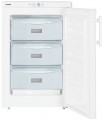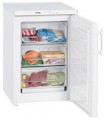Max. temperature
The highest temperature maintained by the freezer during normal operation. This parameter is not as important as the minimum freezing temperature, however, it allows to evaluate the optimal conditions for storing certain categories of products that do not need deep freezing. And in some cases, it shows that the freezer can
work as a refrigerator.
Minimum temperature
The lowest temperature that the freezer can maintain in normal operation. First of all, the duration of food storage in the freezer depends on this parameter: it is believed that a temperature of -12 ° C is enough to preserve food for a month, -18 ° C – 3 months, -24 ° C – up to a year. At the same time, it must be taken into account that not only temperature affects the shelf life but also the type of product and its quality before freezing.
Fast freeze
It is the forced freezing mode, in which the temperature inside the freezer is briefly reduced to -24 °C. This mode is intended for the case when you need to freeze numerous products at the same time — without a sharp decrease in temperature, the heat from numerous non-frozen products could lead to its critical increase.
Usually, the fast freeze mode must be turned on in advance — 5 to 6 hours before loading the products. Thus the freezer has time to decrease the temperature in the chamber. In this case, it is necessary to take into account the increased load on the compressor — it is impossible to turn on fast freeze for a long time. In some models, automatic shutdown of the fast freeze mode is provided. In some, it must be done manually.
Controls
The type of control provided in the freezer. This parameter is specified by the type of controls and their location.
- Rotary knobs. In general, this is the simplest and most inexpensive option used in units of the appropriate level. However, even this is quite enough - especially if the freezer works in more or less constant temperature conditions (for example, in a home or office kitchen). In many cases, the matter is limited to selecting the appropriate knob position once and then not changing the settings. In addition, the major advantages of this type of control are reliability and ease of repair.
- Push-buttons. Push-buttons are considered more advanced than rotary knobs. The specific functionality of freezers with such a control may be different. But among them, models with additional functions and the ability to fine-tune the temperature are noticeably more common. As for the location, there are internal and external push-buttons. The internal location allows you to hide the control panel behind the refrigerator door, providing a neat appearance with a minimum of protruding parts.
The external location is convenient because you do not need to open the door to access the settings. On the other hand, the real need for such an arrangement is not so often, and the control panel must also fit into the overall design of the unit (which is not always possible to do in the best way).
- Touch controls. Touch controls are considered th...e next step in the development of control panels, after buttons. So, it looks stylish and technologically advanced, they do not need to be pressed hard (just touched), and there are no protruding parts, corners or slots on the surface of the panel, which simplifies cleaning from dirt. The presence of a touch panel is typical mainly for models of the middle and top levels. It costs a little more than a push-button one, but this is imperceptible against the total price of the units. But the internal location, in this case, is much less common than the external one. It is because there is no need to hide the touch panel behind the door. It can easily fit into the design of the device. In addition, external placement allows you not to open the door again to access the settings.
Energy class
The energy class shows how economical the freezer is in terms of electricity consumption. Initially, the classes were designated in Latin letters from A (most economical) to G (high power consumption). Recently, improved classes A+, A++ and A+++ appeared (the more pluses - the more economical the device).
It should be borne in mind that this indicator represents not the actual energy consumption but the efficiency of the unit compared to similar models. Therefore, a small class A freezer may have a lower power consumption than a large class A++ model. And other things being equal, a more economical device, as a rule, costs more, but this difference can quickly pay off during the operation.
Energy class (new)
This parameter shows the efficiency of electricity consumption by the freezer. Classes are designated in Latin letters from A to G, in ascending order of energy consumption. It was originally conceived until more energy-efficient models pulled up to class A, which eventually received the marking A+, A++, and A+++. Further development of technology has made it possible to go even further and, in order not to produce pluses in energy efficiency labelling, in March 2021, manufacturers returned to the previous indices from G to A, where A is the most energy-efficient freezer. Accordingly, the 2021 models will have modern markings, while older models will be marked the old way.
Energy consumption per year
It is the average amount of energy consumed by the freezer in a year of operation. Of course, these figures are not absolutely accurate. The actual power consumption may vary depending on the specific operating conditions. However, this parameter makes it possible to evaluate the consumption of the device and compare different models with each other. At the same time, it often turns out to be more convenient and visual than the energy consumption class (see above) because, in this paragraph, we are talking about a specific figure (from which you can also calculate the cost of electricity consumed).
Climate class
The climate class to which the freezer corresponds.
As the name implies, this parameter describes the environmental conditions for which the unit is designed. The warmer it is around, the more powerful the freezer should be and the better thermal insulation it should have. Specific classes are indicated by letters. Here are the most popular options:
— SN (subnormal). Models for a cool temperate climate have an operating range from +10 °C to + 32 °C. Such a unit can be useful in a poorly heated room where the temperature can drop below +16 °C — for example, on the veranda of a private house, in a garage, etc.
— N (normal). Freezer for a temperate climate, with an operating temperature range of +16...+32 °C. Such a unit is suitable for most residential apartments and houses in mid-latitudes.
— ST (subtropical). Models for subtropical and humid tropical climates. Normally they work at the range of external temperatures +18...+38 °C.
— T (tropical). Refrigerators for dry tropical climates. Designed for temperature range +18 °C to +43 °C.
Also, note that there are many models on the market with an extended temperature range covering several classes. For example, a unit labelled N-ST will have a temperature range of +16...+38 °C. These freezers are indispensable in climates, conditions which are not covered by one standard class — for example, in cold winters and hot summers.
Operation at sub-zero temperatures
The ability of freezer to work at sub-zero temperatures allows you to take it out to an unheated room. And chest freezers can be used outdoors.

